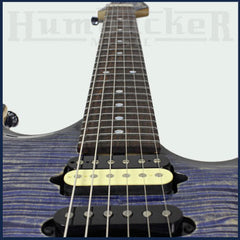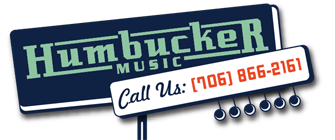Fretboard Radius Explained
 We've found over the years that feel is what really draws a player to a certain guitar. Sure the aesthetics are what may first catch one's eye, but in our experience it is the feel that gives a player that "got to have it" syndrome. That being said, feel tends to be a very subjective topic and many aspects play a role. It is hard to narrow it down to just one key feature, as it is often a series of things coming together just right to make a great playing guitar. Though it may be different for each player, there are a few elements to consider that promote one type of feel over another. Fretboard radius is one of the elements that contributes quite significantly to the overall playabilty of a guitar. In this article we take a look at what exactly fretboard radius is and why it really matters.
We've found over the years that feel is what really draws a player to a certain guitar. Sure the aesthetics are what may first catch one's eye, but in our experience it is the feel that gives a player that "got to have it" syndrome. That being said, feel tends to be a very subjective topic and many aspects play a role. It is hard to narrow it down to just one key feature, as it is often a series of things coming together just right to make a great playing guitar. Though it may be different for each player, there are a few elements to consider that promote one type of feel over another. Fretboard radius is one of the elements that contributes quite significantly to the overall playabilty of a guitar. In this article we take a look at what exactly fretboard radius is and why it really matters.How Is Fretboard Radius Measured?
Anyone who has ever taken a look at guitar specs has surely seen a measurement for fretbaord radius. Common radiuses (radii) include: 7.25", 9.5", 12", and 16", just to name a few. Though the measurements are commonly found on just about every guitar spec sheet, it is rarely explained what these measurements actually mean. The best way to understand fretboard radius is to look at where the measurements are derived from. An illustration may be the best way to explain this without subjecting you to a math lecture :). Imagine three circles with radii of 7.25", 9.5" and 16". Now if we were to cut out a section from the sides of each of the circles the width of a fretboard imagine how the sections would differ from one another. All three would have a subtle curvature to them, however the section that came from the 7.25" circle would have considerably more than that from the 16" circle. Basically as the radius grows larger, the section gets progressively flatter. Here is a good illustration of exactly what we are talking about:

Here is a close up shot of the top part of the image above:

What Is the Purpose of Fretboard Radius?
The idea behind fretboard radius is to have the fretboard more consistently match the natural curvature of a human hand. If you really think about it, it would be a great deal easier to manufacture fretboards that are perfectly flat rather than with a precise subtle curve to them, and as we will explain a bit later, it would actually make a functionally better fretboard. The problem with a perfectly flat board is that it would not be very comfortable, as it would not conform very well to the curvature of most players fretting fingers. Our fingers are not perfectly straight. In fact, if you hold your fretting hand in the playing position, the amount of curve is quite significant. This is why during the manufacturing process much care is taken in order to sand a fretboard to a certain radius as well as press the frets in order to have them adhere to this radius. It is actually a pretty involved process when you think about it, but completely worthwhile when you consider the impact it has on how the guitar plays. Feel really is king when it comes to guitars.
The Effect of Radius on Playability
Each manufacturer has a different standard fretboard radius and some even differ by model. Many vintage Fender guitars have a radius of 7.25", whereas most Gibson guitars tend to have a flatter 12" radius. The reason for this is that there are advantages and disadvantages to each of the different types of fretboard radius, though to what extent is pretty subjective. As a general rule, a more curved fretboard tends to be a bit more comfortable for barring or chording than a flatter one. The idea is that the curvature of the board adheres a bit closer to the curvature of the fingers in the playing position, though the effect is going to be pretty unique to each player. One downside to a more curved board is it does make bending notes a bit more difficult. When a string is bent, it is drawn toward the center of the fret which is higher than the edges and can often buzz on a more curved board. This is what may make a flatter board a bit more appealing to the guitarist that tends to bend more in their playing. The flatter board does diminish this effect, allowing for lower action without fret buzz and a bit easier bending. Speaking in a very general sense, a more curved board is better for chording and a flatter board is better for single notes. This is just a generalization, you really should try a variety of guitars to find the one that is most comfortable for you. It should also be noted that a good setup has a much more significant impact on playability than fretboard radius alone in our experience. Please see our quick setup tip at the end of the article, as it relates to fretboard radius.
Compound Radius
One great way that some manufacturers have addressed the strengths and weaknesses of the different fretboard radiuses is by creating boards with compound radiuses. This is an idea that definitely seems to be gaining some popularity as more players experience the advantages. With this type of board, the radius actually changes as you travel up the board. The idea is to provide a more curved board at lower frets where many players tend to chord more and a flatter board at the higher frets for easier lead work. It is basically the best of both worlds and makes for a great playing guitar all the way up the neck. Fano and Suhr are two companies among many others that have employed this idea, and we constantly get feedback from customers about how great these guitars play. If you get a chance to test drive one, it is definitely worth checking out a guitar with a compound radius. Most players may be quite surprised at what a difference it makes.
Quick Fretboard Radius Setup Tip
With all the discussions about what fretboard radius does for the playability of a guitar we thought it would be a good idea to include a setup tip that will benefit all players. A very common mistake that many players make when they are setting up their guitars is failing to match the bridge radius to the fretboard radius. This is one sure-fire way to end up with an awkward playing guitar, unfortunately. Most of us obsess quite a bit over the height of our action, however, we often fail to make sure that the curvature of the strings matches that of the fretboard. What we end up with is low action, but the guitar still just does not seem quite right. We have all done it :).
Here is a quick check to make sure that the radius set at the bridge is consistent with the fretboard radius:
With the guitar tuned up to pitch, measure the height of each string from the bottom of the string to the top of the fretboard at the twelfth fret. Theoretically, if the radius matches that of the fretboard, you should end up with the same measurement for each string. Many bridges will allow you to adjust the individual height of the strings in order to more precisely set this radius. It is definitely worth a quick check; it makes a huge difference in how the guitar plays.




